This Yellow Chamomile Cold Process soap is cheerful and bright. This project is made with with Chamomile Bergamot Fragrance Oil and topped with chamomile herbs; it smells like a calming cup of tea. Chamomile extract is also added at trace to give additional skin-soothing properties. Made in the 4″ Silicone Loaf Mold, this mold creates four 1″ bars of soap. It’s ideal for smaller recipes or even test batches.
The vertical stripes are achieved by pouring the white and yellow soap into opposite ends of the mold at the same time. The colors are then swirled back and forth with a chopstick or dowel which pulls the colors into the other colored area. This technique is great for beginners, as you do not have to be precise when swirling.
What You’ll Need:
4″ Silicone Loaf Mold
2.8 oz. Coconut Oil
2.8 oz. Olive Oil
2.8 oz. Palm Oil
2.1 oz. Rice Bran Oil
2.1 oz. Sweet Almond Oil
1.4 oz. Cocoa Butter
1.9 oz. Sodium Hydroxide Lye
4.6 oz. Distilled Water
Yellow Oxide
Titanium Dioxide
1 oz. Chamomile Bergamot Fragrance Oil
1 Tbs. Chamomile Extract
Chamomile Herbs, Egyptian
 Click here to add everything you need for this project to your Bramble Berry shopping cart!
Click here to add everything you need for this project to your Bramble Berry shopping cart!
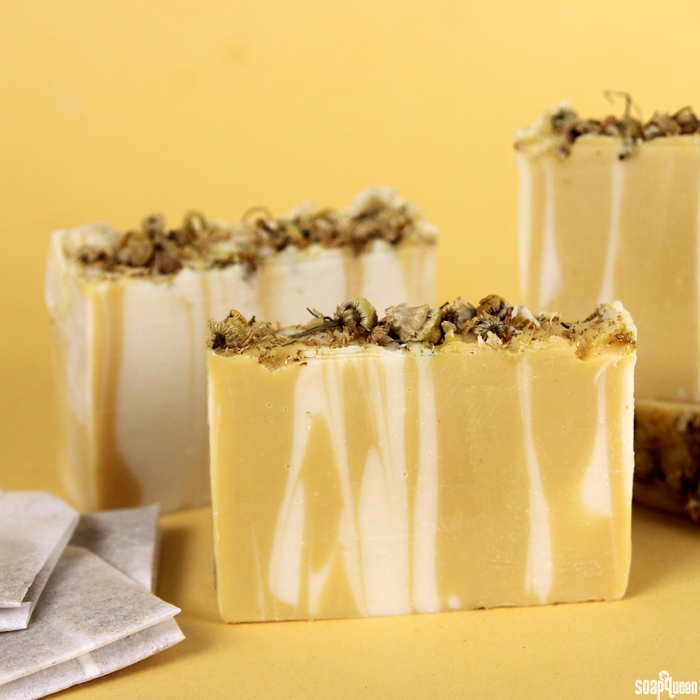 If you’ve never made Cold Process soap before, stop here! I highly recommend checking out our FREE four part SoapQueen.tv series on Cold Process Soapmaking, especially the episode on lye safety. And if you’d rather do some reading, Bramble Berry carries a wide range of books on the topic, including my newest book, Soap Crafting. You can also checkout the digital downloads for that instant gratification factor.
If you’ve never made Cold Process soap before, stop here! I highly recommend checking out our FREE four part SoapQueen.tv series on Cold Process Soapmaking, especially the episode on lye safety. And if you’d rather do some reading, Bramble Berry carries a wide range of books on the topic, including my newest book, Soap Crafting. You can also checkout the digital downloads for that instant gratification factor.
SAFETY FIRST: Suit up for safe handling practices! That means goggles, gloves and long sleeves. Make sure kids, pets, and other distractions and tripping hazards are out of the house or don’t have access to your soaping space. Always soap in a well-ventilated area.
COLOR PREP: To ensure that the Titanium Dioxide blends smoothly into the soap batter, we recommend micronizing it before dispersing it in oil. Please note this is an optional tip but it does help with the titanium dioxide clumping in the soap =) To micronize colorant, simply use a coffee grinder to blend the colorant to break up any clumps of color and prevent streaks of white from showing in the final soap. We like to use a coffee grinder that has a removable, stainless steel mixing area for easy cleaning. Then, disperse 1 teaspoons of the colorant into 1 tablespoon of sunflower or sweet almond oil (or any other liquid oil). Finally, disperse 1 teaspoon Yellow Oxide into 1 tablespoon of light liquid oil. Use a mini mixer to get the clumps of color worked out smoothly.
ONE: Slowly and carefully add the lye to the water and gently stir until the lye has fully dissolved and the liquid is clear. Set aside to cool.
TWO: Combine the cocoa butter, coconut oil, olive oil, rice bran oil, sweet almond and palm oils (remember to fully melt then mix your entire container of palm oil before portioning). Once the lye water and the oils have cooled to 130 degrees or below (and are ideally within 10 degrees of each other), add the lye water to the oils and stick blend until thin trace. If you’d like a harder bar of soap that releases faster from the mold, you can add sodium lactate to the cooled lye water. Use 1 teaspoon of sodium lactate per pound of oils in the recipe. For this recipe, you’d add about 1 tsp. sodium lactate.
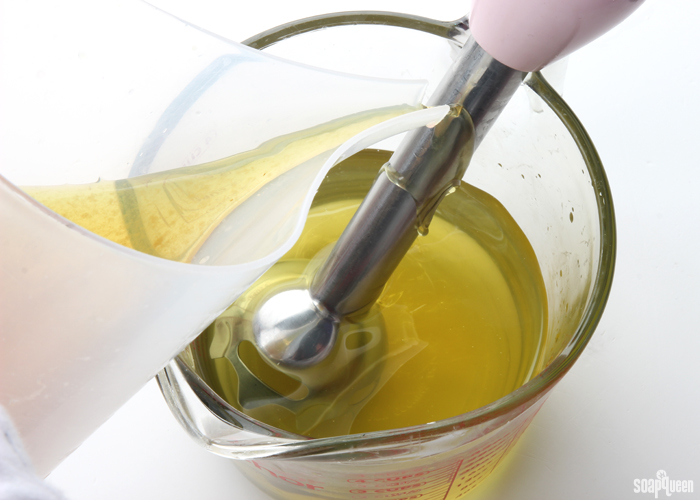
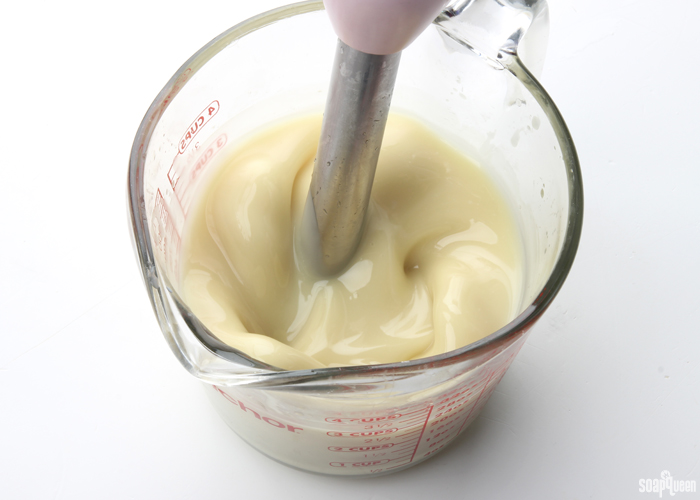 THREE: Once you’ve reached a light trace, add 1 tablespoon of chamomile extract and stir in with a whisk.
THREE: Once you’ve reached a light trace, add 1 tablespoon of chamomile extract and stir in with a whisk.
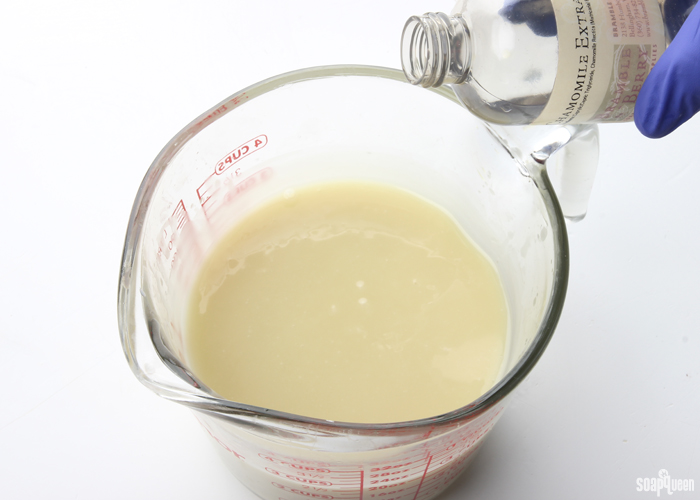 FOUR: Split the batch in half, it’s okay to eyeball it! To one container, add 2 tsp. dispersed yellow oxide and stir in with a whisk.
FOUR: Split the batch in half, it’s okay to eyeball it! To one container, add 2 tsp. dispersed yellow oxide and stir in with a whisk.
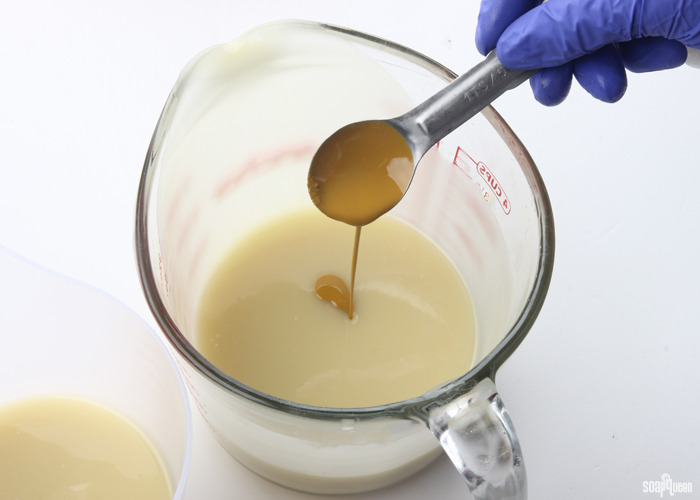 FIVE: To the other container, add 1 tsp. dispersed titanium dioxide and whisk in.
FIVE: To the other container, add 1 tsp. dispersed titanium dioxide and whisk in.
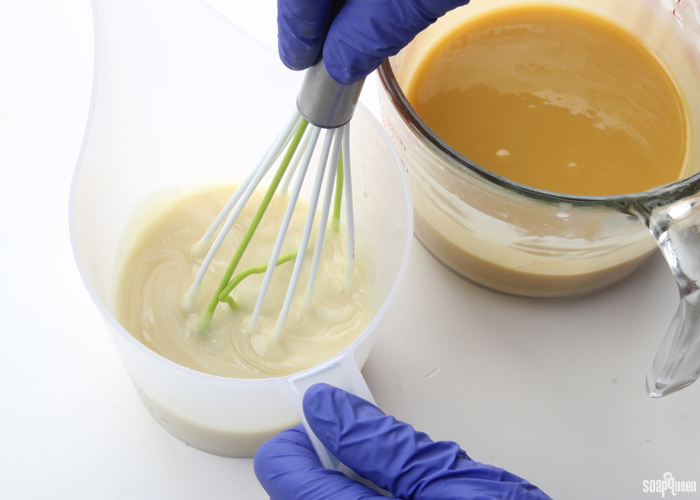 SIX: Add .5 oz of Chamomile Bergamot Fragrance Oil into each container, and use a whisk to thoroughly combine.
SIX: Add .5 oz of Chamomile Bergamot Fragrance Oil into each container, and use a whisk to thoroughly combine.
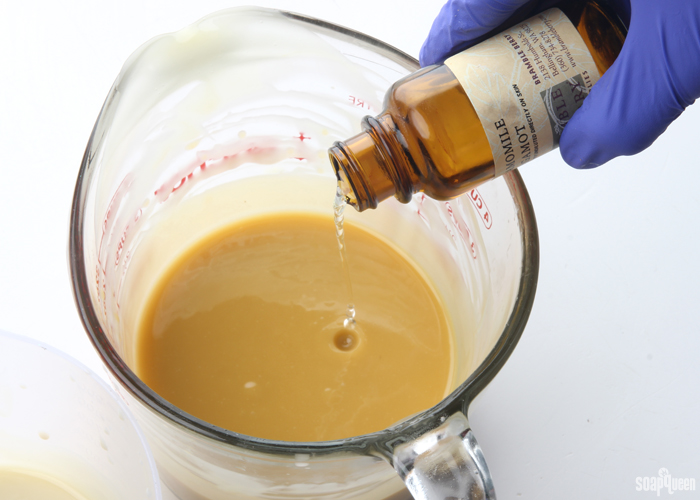 SEVEN: At the same time, pour each color into opposite sides of the mold. At this point, your soap will be a medium trace. If it is still thin, give it a few short pulses with the stick blender to thicken. If the soap is poured while thin, the two colors may blend together too much and become muddled.
SEVEN: At the same time, pour each color into opposite sides of the mold. At this point, your soap will be a medium trace. If it is still thin, give it a few short pulses with the stick blender to thicken. If the soap is poured while thin, the two colors may blend together too much and become muddled.
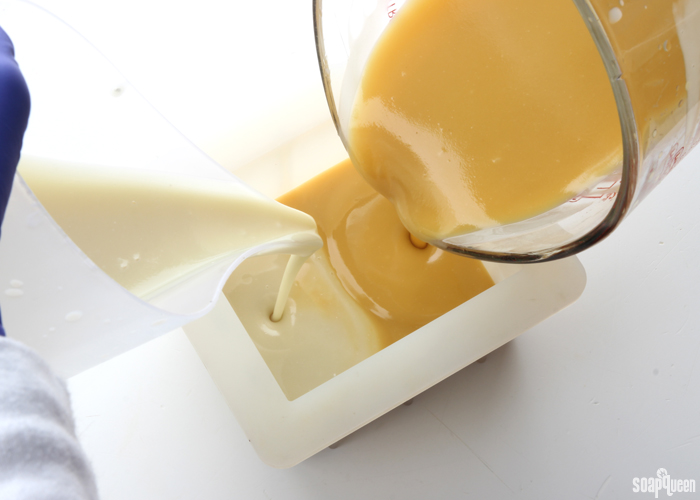 EIGHT: Insert a chopstick or dowel down to the bottom of the mold. Then, move the dowel back and forth horizontally through the soap, making about four or five motions.
EIGHT: Insert a chopstick or dowel down to the bottom of the mold. Then, move the dowel back and forth horizontally through the soap, making about four or five motions.
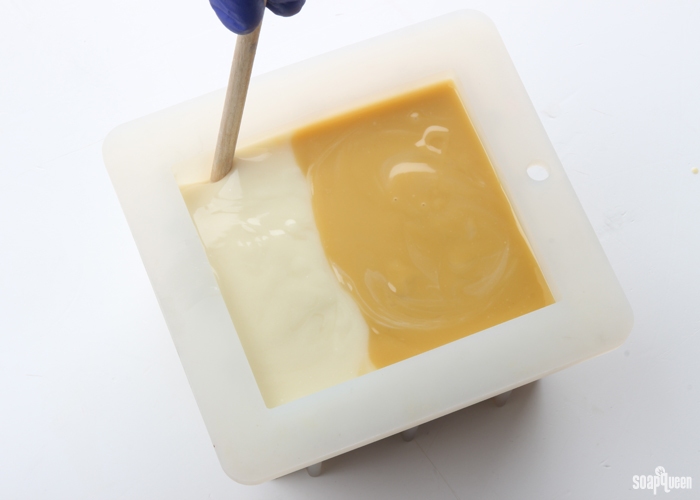 NINE: Then, insert the swirling tool down to the bottom of the mold, and move it back and forth vertically through the soap. Repeat this process twice. No need to be super precise!
NINE: Then, insert the swirling tool down to the bottom of the mold, and move it back and forth vertically through the soap. Repeat this process twice. No need to be super precise!
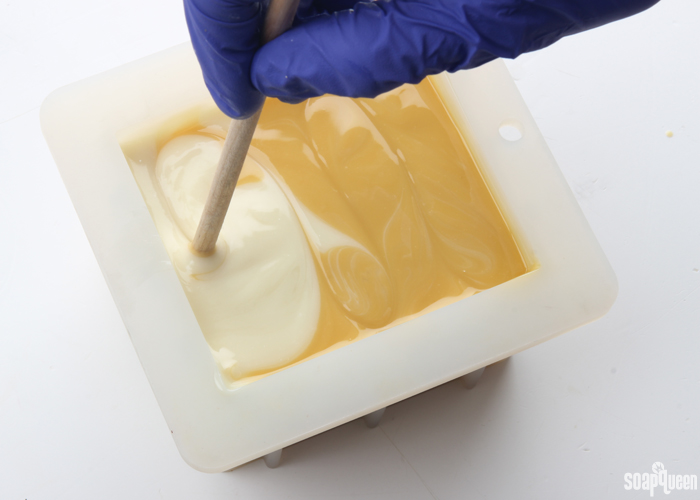 TEN: Tap the mold firmly down on the counter to release any bubbles.
TEN: Tap the mold firmly down on the counter to release any bubbles.
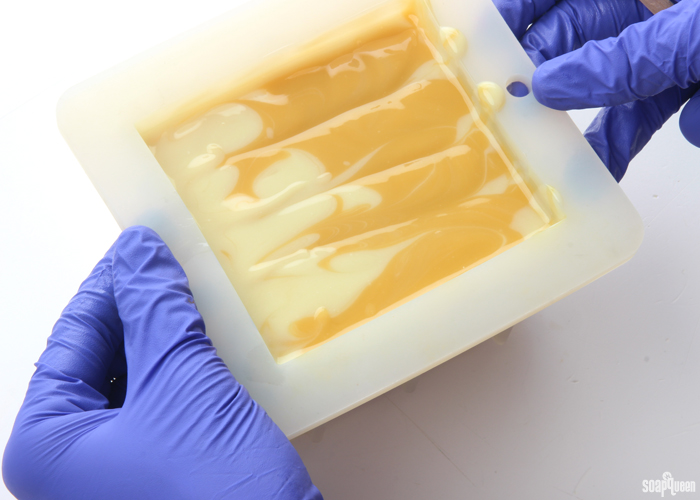 ELEVEN: Sprinkle chamomile herbs on top of the soap, and press them down gently to ensure they adhere.
ELEVEN: Sprinkle chamomile herbs on top of the soap, and press them down gently to ensure they adhere.
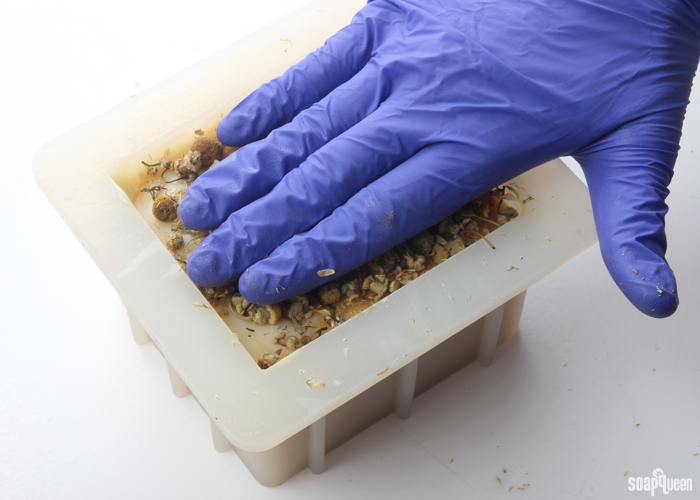 Spray soap with 99% rubbing alcohol and allow the soap to sit in the mold for 48-72 hours. When it’s time to cut, flip the soap on its side and cut. If you cut from the top down, the herbs may cause drag marks.
Spray soap with 99% rubbing alcohol and allow the soap to sit in the mold for 48-72 hours. When it’s time to cut, flip the soap on its side and cut. If you cut from the top down, the herbs may cause drag marks.
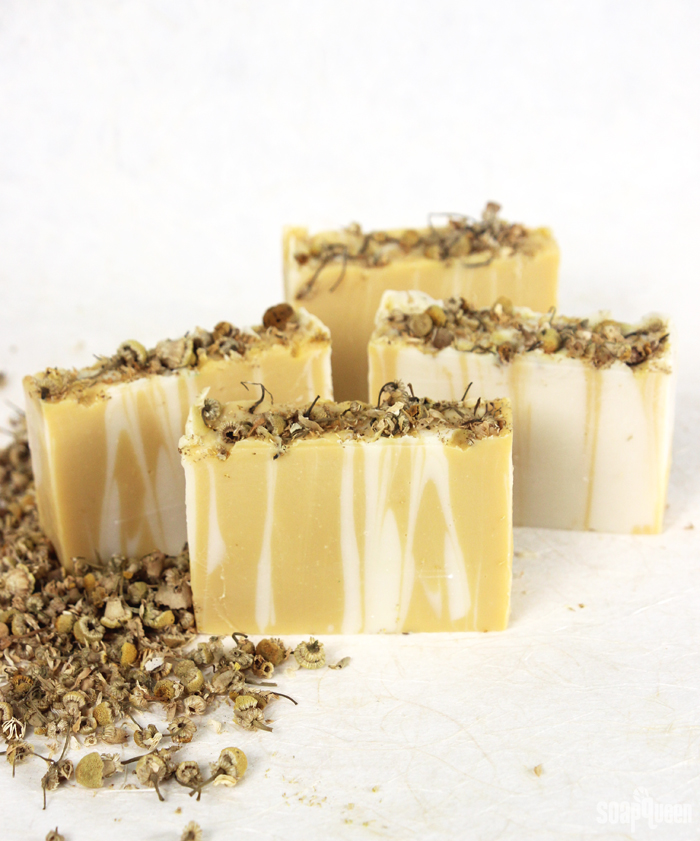
- 4″ Silicone Loaf Mold
- 2.8 oz. Coconut Oil
- 2.8 oz. Olive Oil
- 2.8 oz. Palm Oil
- 2.1 oz. Rice Bran Oil
- 2.1 oz. Sweet Almond Oil
- 1.4 oz. Cocoa Butter
- 1.9 oz. Sodium Hydroxide Lye
- 4.6 oz. Distilled Water
- Yellow Oxide
- Titanium Dioxide
- 1 oz. Chamomile Bergamot Fragrance Oil
- 1 Tbs. Chamomile Extract
- Chamomile Herbs, Egyptian
- Slowly and carefully add the lye to the water and gently stir until the lye has fully dissolved and the liquid is clear. Set aside to cool.
- Combine the cocoa butter, coconut oil, olive oil, rice bran oil, sweet almond and palm oils (remember to fully melt then mix your entire container of Palm Oil before portioning). Once the lye water and the oils have cooled to 130 degrees or below (and are ideally within 10 degrees of each other), add the lye water to the oils and stick blend until thin trace. If you’d like a harder bar of soap that releases faster from the mold, you can add Sodium Lactate to the cooled lye water. Use 1 teaspoon of Sodium Lactate per pound of oils in the recipe. For this recipe, you’d add about 1 tsp. Sodium Lactate.
- Once you’ve reached a light trace, add 1 tablespoon of chamomile extract and stir in with a whisk.
- Split the batch in half, it’s okay to eye ball it! To one container, add 2 tsp. dispersed yellow oxide and stir in with a whisk.
- To the other container, add 1 tsp. dispersed titanium dioxide and whisk in.
- Add .5 oz of Chamomile Bergamot Fragrance Oil into each container, and use a whisk to thoroughly combine.
- At the same time, pour each color into opposite sides of the mold. At this point, your soap will be a medium trace. If it is still thin, give it a few short pulses with the stick blender to thicken. If the soap is poured while thin, the two colors may blend together too much, and the colors may become muddled.
- Insert a chopstick or dowel down to the bottom of the mold. Then, move the dowel back and forth horizontally through the soap, making about four or five motions.
- Then, insert the swirling tool down to the bottom of the mold, and move it back and forth vertically through the soap. Repeat this process twice. No need to be super precise during this process!
- Tap the mold firmly down on the counter to release any bubbles.
- Sprinkle chamomile herbs on top of the soap, and press them down gently to ensure they adhere.
- Spray soap with 99% rubbing alcohol and allow the soap to sit in the mold for 48-72 hours. When it’s time to cut, flip the soap on it’s side and cut. If you cut from the top down, the herbs may cause drag marks.
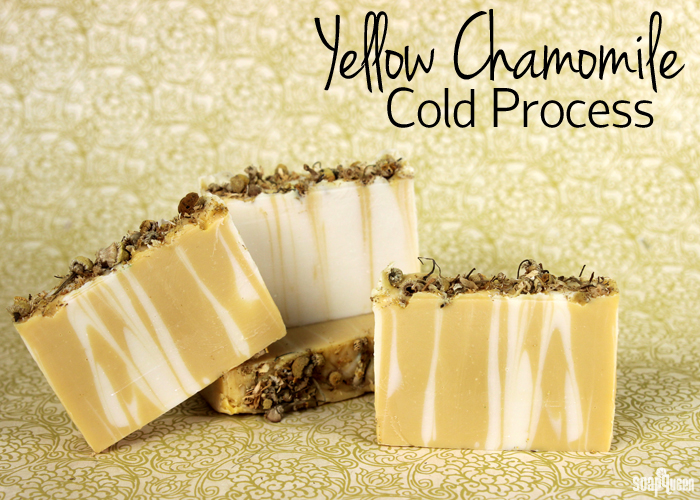
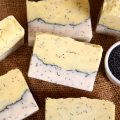

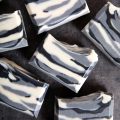
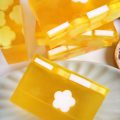
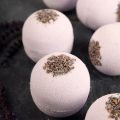
I am just starting out making CP soap and am not ready to invest in EO or FO. Is there a way to add scent with chamomile tea? I’ve heard of infusing the oils but I’m not sure how much scent that will add because the recipes usually call for EO or FO also. Could you also infuse the water with the tea before adding the lye? Would there be any benefits or would the soaping process destroy the scent? Thank you!
You can infuse the water with tea before adding it to soap! Find out how in this post: https://www.soapqueen.com/bath-and-body-tutorials/tips-and-tricks/use-tea-coffee-soap/
On its own, the tea won’t scent your batch very much. The smell will be very subtle and you may not notice it. It does add a nice color and marketing appeal though. 🙂
If you want some strong tea scents, you can use fragrance oils. We have some really great ones. You can find a list of them at the bottom of the post linked above. Learn how much to add with our Fragrance Calculator: https://www.brambleberry.com/Pages/Fragrance-Calculator.aspx
-Kelsey with Bramble Berry
Thank you for all the great info! I am learning so much through your site. I have a growing list of Brambleberry scents that I want to try and I will be adding the tea scents to the list.
Hi, I made this soap today and when I was washing up I noticed that the soap was very oily on my hands. Will the soap not be as oily later on or is it going to stay this way? Also if it does stay oily is there something I can do with the soap or can I add more lye to it? Thanks so much, love your program.
Thanks Dorothy, glad you love the blog! How long did you let the soap cure? If it’s still really fresh there can be more soap residue, which can feel oily. After 4-6 weeks, it hardens up nicely and there is less residue on the hands. Let me know! 🙂
-Kelsey with Bramble Berry
Finally 4 weeks are up and I used my soap! This is my favorite soap so far. I’ve only made 6 recipes but this one is so lovely. I used all the ingredients from Brambleberry as recommended. I do have a couple of questions.
The chamomile flowers turned a seaweed green while the soap was in my shower. Kind of yucky, so I shaved them off. Is this typical when adding decorative flowers on top? Or did I do something wrong?
I’d also like to know if this recipe is gentle enough for the face. I’m wanting to make a facial soap bar that is good for dry skin. Can I use this recipe or is there another recipe in this site that would be better?
Thanks!
So glad the soap turned out well Nitza! Natural ingredients like chamomile flowers can turn brown or mold when exposed to mold in the shower. That is normal! If you’re not a fan, you can definitely skip the chamomile flowers on top for your next batch. 🙂
Also, this recipe is fairly gentle so you can use it on the face! Facial skin tends to be more sensitive and everybody’s is different, so I would recommend testing the bars on your face to see what you think. If you want the bars more cleansing or more gentle, you can adjust from there! Get more tips on formulating cold process recipes here: http://www.soapqueen.com/bath-and-body-tutorials/tips-and-tricks/how-to-store-handmade-bath-products/
A great option for the face is castile soap. It’s made with 100% olive oil, which is gentle and soothing on the skin. Read more about castile soap here: http://www.soapqueen.com/bramble-berry-news/olive-oil/
-Kelsey with Bramble Berry
I’ve made this soap twice now, and wasn’t able to achieve the same design as you did. The first time it became more of a two color appearance, the second time I did more swirls, but the colors muddled together too much. I hope next time I will be able to achieve the average between the two because this soap is a delight to use with it’s uplifting fragrance at almost 7% (!). I think I just love strong fragranced soaps and have to exceed the level ‘strong’ of your fragrance calculator in my coming soapmaking…The second time I made this soap, I also found a solution for getting the dried chamomile flowers everywhere on the bars while cutting them and maybe fellow soapers do have the same difficulties. Now I cut the bars while still a bit soft, push the bars together again, wet the top, push the flowers firm but gently in the soap, spray with a bit of alcohol and leave to dry for one day. Then I take the individual bars, which are nice and clean then, to cure.
Hi Zala!
To get this design, trace is an important factor. If it’s a bit too thick, it may not swirl as well. Too thin, and the colors can muddle together. You want a nice medium trace, which is like a thick cake batter or thin pudding. You can see an example of that here: http://www.soapqueen.com/bath-and-body-tutorials/tips-and-tricks/trace/
The great news is the bars will look great, even if the batter is a little thick or thin! That’s what’s fun about making swirled soaps – the bars look a little different each time!
Also, thanks so much for your tip! It sounds like it makes great bars. 🙂
-Kelsey with Bramble Berry
Thanks for your reply, Kelsey! I guess I’m not a talented soaper, but I do have a strong desire to learn and to develop my skills. I appreciate to have your support at hand!
You’re welcome! It does take a bit of practice to get trace just right! When I first started I had a ton of muddled colors because I was afraid of getting the soap too thick. You’ll get the hang of it in no time. 🙂
-Kelsey with Bramble Berry
Hi, I made this soap without any color or fragrance and added some crushed chamomile flowers into the mixture at trace. It seemed to go well but now 3 weeks later there are grey/black mouldy spots in it. Is this common with adding herbs and do you have any advice to prevent it please?
Thank you 😀
Also I don’t know if it made a difference but I think I put double the amount of chamomile extract in the soap as I had to answer my front door while I was making it and lost track of what I was doing.
Hi Helen!
Because the chamomile flowers are natural, they can eventually turn brown and grow mold. That is normal when working with fresh ingredients! It can help to dry the flowers out before adding to your batch, but they will eventually go brown as well. The soap should be fine to use, but may start to get an unpleasant smell after awhile.
Also, the additional extract won’t make the soap mold! It is mixed with fractionated coconut oil rather than water. 🙂
Sunday Night Spotlight: Extracts: http://www.soapqueen.com/bramble-berry-news/sunday-night-spotligh-extracts/
-Kelsey with Bramble Berry
Question:
I rarely use exfoliants, but if I wanted to grind up some chamomile flowers to add to this recipe, is 1 tsp per lb of soap about right?
Thanks for you help!!
Sly
Hi Sly!
That is correct! Adding about 1 tsp. of exfoliants per pound of soap is a good place to start. If you want it even more scrubby, you can add more. 🙂
-Kelsey with Bramble Berry
Chamomile herb: https://www.brambleberry.com/Chamomile-Herb-Egyptian-P4014.aspx
Hi,
Thanks for all the wonderful recipe you share. I’m a new soap maker and have been learning so much from your site. Have this question about this recipe, I don’t have Chamomile Extract, will the recipe work if i don’t use it? Is Chamomile Extract, Chamomile infused oil? I do have the dried herb but don’t have the extract.
Thanks,
Je..
Hi Jeyatha!
You’re so welcome, glad you like the recipe!
Chamomile extract is different from chamomile infused oil. We used the extract in this recipe because it is thought to add soothing properties. However, it is optional! You can leave it out and the soap will still feel wonderful. 🙂
-Kelsey with Bramble Berry
Thank you Kelsey.. I’m going to try it without the extract as of now. Will keep the details on my notes so that I can find Chamomile Extract latter. 🙂
Hi Je!
Sounds good! Taking lots of notes is really helpful when you’re soaping. 🙂
-Kelsey with Bramble Berry
Hi. Do you have advice on how toake a bigger batch of this for my 10 inch silicone mold?
Thanks!
Hi TJ!
A great way to resize your batch is to convert it to percentage. To do that, type all the ingredients into the Lye Calculator and hit “Calculate.” Next to the oil amounts will be a percentage. This recipe is:
Cocoa Butter: 10.00%
Coconut Oil: 20.00%
Olive Oil: 20.00%
Palm Oil: 20.00%
Rice Bran Oil: 15.00%
Sweet Almond Oil: 15.00%
Then, go back to the Lye Calculator and switch the units to “Percentage.” You can enter the total weight your mold holds and plug in those percentages. That will give you the amount you need for your mold. 🙂
-Kelsey with Bramble Berry
Using the Bramble Berry Lye Calculator: http://www.soapqueen.com/bath-and-body-tutorials/cold-process-soap/using-the-bramble-berry-lye-calculator-2/
Thank you so much! Cannot wait to try this. I have been super impressed with brambleberry products and the company in General. Very very helpful and timely in your responses. Thanks again!!
You are so welcome! We are happy to help. Also, thanks for your kind words. 🙂
-Kelsey with Bramble Berry
Hi Kelsey!
So I am getting ready to make this ( got distracted with other soap recipes) and I am not sure I’m using the lye calculator correctly. You told me
Cocoa butter 10%
Coconut oil 20%
Palm oil 20%
Olive oil 20%
Rice bran oil 15%
Sweet almond oil 15%
Ok I plugged that into the calculator. Now my 10 inch silicone mold I believe holds 50 ounces. So we it asked for the total ounces i put 50. The results I got were
Cocoa butter 5 oz
Coconut oil 10oz
Olive oil 10 oz
Palm oil 10oz
Rice bran oil 7.5o
Sweet almond oil 7.5oz
Milk ( liquid) 16.5 oz
Lye 6.85 oz
Does this seem correct? It then gave a total weight of 70 ounces! So I was confused.
Also, how to I adjust the chamomile extract and color ants for a larger batch? I’m so sorry for the dumb questions. I just want to get this recipe right and not waste ingredients.thanak for your help!!
Hi TJ!
No worries, I am happy to help!
When it comes to the Lye Calculator, you will have to do a bit of guessing on how much your oils will weigh. Sorry about any confusion!
So, let’s say you guess that your oils will weigh 30 ounces total. When you calculate that at a 5% superfat, that only gives you 44 ounces. To get more, enter in a new guess in the “Resize Batch” portion and hit “Resize.” Eventually, you will get 50 ounces! It this case, 34 ounces of oil will give you 49.88 ounces of soap. 🙂
Lye Calculator: https://www.brambleberry.com/Pages/Lye-Calculator.aspx
Also, when it comes to extracts you want to use 1 tsp. per pound of soap. So, because your soap is about 3 pounds, that would mean you’ll add 3 tsp. of chamomile extract.
Sunday Night Spotlight: Extracts: http://www.soapqueen.com/bramble-berry-news/sunday-night-spotligh-extracts/
Colorants are a bit more tricky. How much you add depends on your personal preference, the color you’re using, the color of the oils in your batch, etc. With a 3 pound batch, I would recommend mixing 2 teaspoons of each colorant into 2 tablespoons of a lightweight oil, like sweet almond oil. Then, add 1 teaspoon of the dispersed color until you get your desired shade.
See that process in action in the Prepare Colorants for Cold Process Soapmaking video: http://www.soapqueen.com/bath-and-body-tutorials/tips-and-tricks/learn-prepare-colorants-cold-process-soap-making/
The Talk It Out Tuesday: Colorants post may be helpful as well: http://www.soapqueen.com/bath-and-body-tutorials/tips-and-tricks/talk-it-out-tuesday-colorants/
If you have leftover colors, you can store them in an airtight container for later use. They will last as long as the oil does. Just make sure to mix them well before use, as the colorants can settle. 🙂
Find oil shelf lives in the Free Beginner’s Guide to Soapmaking: Common Soapmaking Oils: http://www.soapqueen.com/bath-and-body-tutorials/tips-and-tricks/free-beginners-guide-to-soapmaking-common-soapmaking-oils/
-Kelsey with Bramble Berry
Wow!! Thank you thank you thank you!! I think understand the lye calculator better now. Thanks soooo much!!
You’re welcome TJ! 🙂
Love it! Would like to make it too.
I am going palm free for environmental reason. Would you please recommend a replacement oil?Thanks
Hi Tina!
Palm oil adds some great firmness to your soap, and there is no direct replacement for it. You can use palm kernel flakes or tallow to add firmness to your bars! Learn how in the How to Substitute Oil in Cold Process Recipes post: http://www.soapqueen.com/bath-and-body-tutorials/tips-and-tricks/how-to-substitute-oil-in-cold-process-recipes/
We also have a lot of great palm free recipes you may like. I’ll include links below. 🙂
Palm Free Vertical Twist: http://www.soapqueen.com/bath-and-body-tutorials/cold-process-soap/palm-free-vertical-twist-tutorial/
Palm Free In The Pot Swirl: http://www.soapqueen.com/bath-and-body-tutorials/cold-process-soap/a-palm-free-in-the-pot-swirl/
Formulating Cold Process Recipes: http://www.soapqueen.com/bath-and-body-tutorials/tips-and-tricks/formulating-cold-process-recipes/
Because palm oil adds firmness, recipes without it can take longer to unmold and cure. To speed this process up, you can add 1 tsp. of sodium lactate per pound of oils to your cooled lye water. Read more in the Sunday Night Spotlight: Sodium Lactate: http://www.soapqueen.com/bramble-berry-news/sunday-night-spotlight-sodium-lactate/
-Kelsey with Bramble Berry
I was wondering if you had any suggestions on how to get the white to swirl thru to the yellow. After swirling 2 complete sets of a horizontal and vertical pull, there was very little pull of the white thru the yellow. Does the lightness/heaviness of trace or the size of the pulling stick make a difference? I cut the loaf on the “short side”, too.
Thanks!
Hi Arlene!
Trace can definitely make a difference when it comes to swirling. We recommend a medium trace for this recipe. That way the soap is thin enough to combine the colors, but thick enough so they don’t become muddled. Also, a couple more swirls with your chopstick can help too! 🙂
-Kelsey with Bramble Berry
All About the Trace: http://www.soapqueen.com/bath-and-body-tutorials/tips-and-tricks/trace/
I made this tonight and I have some questions.
I stopped the blender stick at light trace but by the time I was ready to pour the two mixes into the mold, it was more gloping than pouring. How could I prevent this going forward?
Also, I don’t need to wrap it in a blanket? Is this because of the silicon mold?
Hi Katy!
Depending on how long the soap is stick blended, it can appear thin at first but start to set up as you’re working. To keep the soap at thin trace, it helps to soap at lower temperatures – around 100-130F. Then, alternate stick blending and stirring manually until that soap is just mixed in. Depending on the recipe, it can take as little as 30-60 seconds. You can read more about that in the All About the Trace blog post: http://www.soapqueen.com/bath-and-body-tutorials/tips-and-tricks/trace/
Also, we didn’t wrap this soap and let it sit at room temperature. But you can definitely insulate this soap if you like!
Jazzed About Gel Phase: http://www.soapqueen.com/bath-and-body-tutorials/tips-and-tricks/gel-phase/
-Kelsey with Bramble Berry
Hi! I love the look of these bars but would like a bit of clarification on the swirling AND cutting please. So you swirl a stick back and forth between the white and yellow layers first, pulling them together then swirl the other direction, then repeat BOTH for a total of 4 swirls or repeat just what you are calling the vertical swirl for a total of 3 swirls??? I guess I am a bit confused as to which is vertical vs horizontal since its sort of a square mold. Also, which way do you cut it? Looks like you’d cut it parallel to the solid colors for what you are calling horizontally? Thanks, Vicki
Hi Vicki!
For this design, we swirled horizontally twice to pull the colors together. Then, we swirled the opposite way (vertically) twice for a total of four swirls. The great thing is you can swirl any way you like! You can swirl more or less depending on how many stripes you want in the bar. 🙂
Also, we cut the soap lengthwise. One side of the mold is slightly longer (4 inches compared to 3 1/2). Cut the bars perpendicular to the short side. Or, cut them on the side that gives you shorter bars. That’s a bit confusing, so let me know if you have any more questions!
-Kelsey with Bramble Berry
I did not understand one thing( As far as I know, extracts are very gentle substances. In lotions and shampoos they are added when the product is cooled down not to kill all the goodness of them. Can it actually survive in CP soap?
Thanks!
Hi Irina!
The properties of extracts do survive in cold process! We recommend adding them at trace for the best results. 🙂
-Kelsey with Bramble Berry
Sunday Night Spotlight: Extracts: http://www.soapqueen.com/bramble-berry-news/sunday-night-spotligh-extracts/
hi there! I’m curious about dispersing the oils….are you pulling the tablespoon of oils from your base recipe for this, or is it an additional Tbs of oils per color? Thanks!!
Hi Briana!
We use an additional amount of oil for our colors. We love that it helps the colors disperse evenly and adds a little bit of luxury to the soap. 🙂
Prepare Your Colorants for Cold Process Soap Making: http://www.soapqueen.com/bath-and-body-tutorials/tips-and-tricks/learn-prepare-colorants-cold-process-soap-making/
If you like, you can use the base oils to mix your colors! You can see that process in action in the Sunshine Soap video on Soap Queen TV: http://www.soapqueen.com/bath-and-body-tutorials/cold-process-soap/making-sunshine-cold-process-soap/
-Kelsey with Bramble Berry
Yay! What a fun soap. I also like that the recipe is a smaller size for beginners. I am always advising starting with smaller batches because it takes many attempts to really get a feel for the whole process.
Hi Margaret!
So glad you like the soap! Also, I definitely agree – smaller batches are great for beginners. They’re also a great way to test colors, fragrances and new ingredients. 🙂
-Kelsey with Bramble Berry
Looks great!
Question about Sodium Lactate- does it cause a lot of ash? I mean more than usual, and not in this particular recipe, but in general? I made a soap recently and added it (1tsp/pop), and it ashed something awful, even on the cut sides after cutting.
Thanks!
I mean 1tsp/ppo not pop. 🙂
Hi Martina!
We use sodium lactate in almost all our recipes and haven’t noticed an excess amount of soda ash. However, several other factors can cause soda ash, such as temperature. If oils and lye water are under 100F and the soap is thin, soda ash can form. Soaping at higher temperatures and pouring at a thicker trace can help prevent this.
The great news is you can remove soda ash! You can steam it off or use an old nylon to wipe it away. I’ll include a post that has more information on soda ash and how to prevent it. 🙂
Explaining and Preventing Soda Ash: http://www.soapqueen.com/bath-and-body-tutorials/tips-and-tricks/explaining-and-preventing-soda-ash/
-Kelsey with Bramble Berry